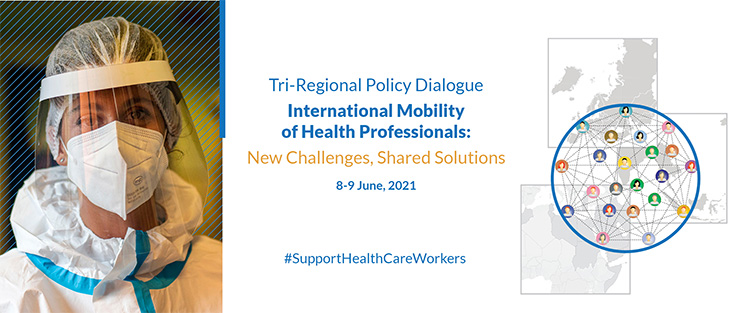
8 June 2021 – In the context of collective efforts to address challenges of international mobility of health professionals, especially during the COVID-19 pandemic, the WHO Regional Directors for the Eastern Mediterranean, Europe and South-east Asia, Dr Ahmed Al-Mandhari, Dr Hans Kluge and Dr Poonam Khetrapal Singh today initiated a virtual tri-regional policy dialogue to review trends and policy responses in the area. They are being joined by representatives of ministries, health professional regulatory bodies, United Nations agencies, development partners, technical experts from the 3 WHO regions and participants from development, education, finance, migration and trade sectors during the 2-day meeting.
The movement of health workers across WHO regions is particularly prominent. As the top countries of origin for migrant doctors working in the Organisation for Economic Co-operation and Development (OECD) countries and 6 of the top countries of origin for migrant nurses were Member States of the 3 WHO regions.
The policy dialogue is a significant part of the activities marking 2021 as the International Year of Health and Care Workers. This unique event aims to discuss challenges, opportunities, policy responses and innovations in WHO regions with respect to ethical international recruitment, fair and effective employment and integration of foreign health workers, and approaches to harness the contribution of diaspora health workers. The international mobility of health workers has been increasing and, with an estimated global shortage of 18 million health workers by 2030, this trend is expected to continue. Strengthened management of mobility – through improved information, policy and international cooperation, framed by the WHO Code on International Recruitment of Health Personnel – is necessary to ensure that escalating health worker mobility contributes to, rather than compromises, advancing universal health coverage and health security across WHO’s Member States.
"The current pandemic has highlighted the centrality of health workers for health security and the health-related Sustainable Development Goals. Countries must invest in a sustainable national health workforce that meets the current and future needs of their populations. That means expanding and transforming the education, training, recruitment, development, distribution, retention and financing of the health workforce, as well as improving working conditions and creating attractive jobs," said Dr Ahmed Al-Mandhari, WHO Regional Director for the Eastern Mediterranean.
“Health and care is the largest employment sector in the WHO European Region, employing some 13 million people. This is one of the reasons why addressing health worker mobility is vital for the 53 Member States we serve. It is also the right thing to do, since investing in the sector in a way that benefits both countries of origin and recipient ones is a future investment and good value for money, in terms of positive impact on economies, societies and health overall,” said Hans Henri P. Kluge, WHO Regional Director for Europe.
“The COVID-19 pandemic has in many ways brought health workforce mobility to the fore. It is time that all stakeholders together chart the path forward, towards increased cooperation between health systems, and towards strengthened health system capacity in both sending and receiving countries. For far too long, the health sector has been side-lined in discussions on health workforce mobility, despite the significant impact this mobility has had, and continues to have, in low- and middle-income countries globally. The health sector must actively promote WHO’s “health-in-all-policies” approach, coordinating with ministries of labour, education, trade and other relevant ministries to inform policy and achieve health-positive outcomes,” said Dr Poonam Khetrapal Singh, Regional Director, WHO South-East Asia Region.
At the recent 74th World Health Assembly (24–31 May 2021) Member States endorsed 2 resolutions on the health workforce, as working for health: protecting, safeguarding, and investing in health workforce, and strengthening global directions of nursing and midwifery (2021-2025).
The COVID-19 pandemic has only further highlighted the need for strengthened cooperation across countries to address domestic gaps in the health workforce through the recruitment of international health workers.


